And after the pandemic?
Slowly but surely, we will defeat the coronavirus. However, it will continue to smoulder like a fire for many months, probably with new smaller local outbreaks. After some time, we may have a vaccine.
I would just like to say two things about the medical aspects. Firstly, that the German government is widely admired throughout Europe because it seems to be handling the epidemic better than any other European country. And secondly, that we have not yet fully understood the behavior of the virus. There is a suggestion that people who have recovered from the infection do not gain immunity and can therefore be re-infected - which is highly unusual for viral diseases. Some politicians have based their thinking on the development of so-called herd immunity, where a significant proportion of the population, once infected and recovered, is no longer able to infect others. This thinking has long been applied to routine immunization of children against measles and other childhood diseases. However, if it is the case that the coronavirus can re-infect those who have previously recovered, the whole theory of herd immunity becomes invalid.
The big question now is, how different will the landscape be once the epidemic has subsided? The question can be broken down into several categories. The first question is how many businesses will survive the lockdown. The hospitality industry - bars, restaurants and hotels - is particularly vulnerable, as is the travel industry. Airlines alone are claiming hundreds of millions of euros from governments, as are small and large businesses and charities. The second question is the impact of people's changing habits during the crisis. Many are now shopping online that supermarkets are struggling to cope with the increased demand. Doctors are engaging with their patients by phone and video calls. Schools, colleges and universities are offering lectures and classes over the internet. On television, most guests are no longer invited into the studio but make their contributions via video calls. Increasingly, radio and television broadcasters as well as printed newspapers and magazines, certainly including "Galvanotechnik", are interacting with authors and companies via the Internet. Why pay the cost of sending journalists and cameramen hundreds of miles, perhaps taking an entire day, when almost the same thing can be accomplished with a video call? And countless millions of employees do their work from home. In all these cases, the motive is reasonably to avoid the risk of infection either at work or on a crowded bus or train. But once that risk has subsided, many people - having proved to themselves or their employers that these new ways of working are feasible - will be tempted to ask why they should return to their previous habits? Employers will ask the same question in many cases. It's true that some managers will never be happy unless the employee is 'under the thumb'. It will be interesting to see how this works out in the future.
Finally, but certainly not least, there is the question of finance and the economy. All experts agree that we will experience a recession (defined by economists as two consecutive quarters of negative economic growth). The only question is how deep this recession will be. Predictions range from minus 6 % to minus 30 %. Most governments are paying out huge sums of money as loans or grants to support businesses and workers. Sooner or later this money will either have to be reclaimed or written off, increasing the national debt. And finally, there is the question of who should bear the losses. For example, if a restaurant is forced to close during the pandemic, it will have no income. How will it then pay the landlord? There will be huge losses and the question will be who should bear them. I have only one sad prediction - namely that lawyers will experience a boom if governments do not establish precise rules.
Is there a silver lining in this gloomy picture? If, as I noted above, millions of people continue their new pattern of working from home, there could be huge savings. The roads and public transportation will be less crowded. There will be less air pollution and less demand for infrastructure investment. As for education at all levels, teaching over the internet is far more efficient, so the cost of education could be significantly reduced. There are already suggestions that managers in industry who have been thinking about investing more in automation are being urged to finally do so. Robots do not catch infections and in some cases allow workers to work at a safe distance from each other. In summary, the cost of this pandemic will be huge, but if it encourages us to increase productivity, this will offset at least some of that cost.
And there could be another benefit. We already import so much, mainly from China. This pandemic has shown the benefits of domestically sourced products. We should import less and produce more, both in Germany and in Europe. Perhaps recent events will push us to do so.
Worried about health? The smart toilet is waiting for you
Fig. 1: The newly developed toilet recognizes the user and analyzes their stool and urineMuchhas been writtenaboutfacial recognition, but the inventors of a new health monitoring system hope to harness what could be described as technology at the other end of the scale. An intelligent toilet (Fig. 1) is the brainchild of scientists at Stanford University and is designed to act as a "benevolent Big Brother". It will analyze daily excretions and look for warning signs of disease, including certain types of cancer. To do this effectively, it needs to know which member of a household is responsible for each sample. This is achieved using a camera-based computer system that is able to distinguish one rear end from another. "It's about giving accurate, individualized health feedback, so we needed to make sure the toilet could distinguish between users," said Sanjiv Gambhir, professor and chairman of radiology at Stanford. His team initially made a flush lever that could read fingerprints. However, they found that this method was not entirely foolproof. What if one person used the toilet but another flushed?
So they added a small scanner that captures an image of the back of each user. The scans simply serve as a recognition system. "No one, neither you nor your doctor, will see the scans," the researchers promise.
Various tests can be performed on the toilet, which can detect a range of disease markers in stool and urine. The investors believe that the toilet could be attractive to those who are genetically predisposed to diseases such as irritable bowel syndrome, prostate cancer or kidney failure and who want to stay on top of their health.
The technology used to carry out the tests can be built into an existing toilet. "It's kind of like buying a bidet add-on that can be installed directly into your existing toilet," Professor Gambhir said. "And like a bidet, it has little add-ons that serve different purposes."
The kit could cost a few hundred euros, and a version that can detect certain types of cancer could be available in three to five years, the researchers say.
Urine and stool samples are captured on video and processed using a series of algorithms that can distinguish normal "urodynamics" (flow rate, flow duration and total volume, among other parameters) and stool consistencies from potentially unhealthy ones.
The toilet system also performs various "dipstick tests" to measure characteristics such as white blood cell count and protein levels. Diseases such as diabetes, bladder and kidney infections as well as kidney and bladder cancer could be detected.
"Everyone uses the toilet every day, it's really unavoidable. And that's what increases its value as a disease detection device ... The smart toilet is the perfect way to use a data source that is normally ignored, and the user doesn't have to undergo any examinations."
Supersonic passenger aircraft: back to the future
Fig. 2: The death flight of Air France Flight 4590 at Charles de Gaulle Airport, Paris July 2000Europeled the world in civil supersonic flight half a century ago with the Anglo-French Concorde, but it was not a happy story. The planes themselves were not economical, they were incredibly noisy, and the US banned supersonic flight over its territory. The project came to a tragic end when an Air France Concorde, Flight 4590, carrying mainly German tourists, crashed in flames not far from Paris in July 2000. There were no survivors. Figure 2, as bad as it is, remains in our memories. Since then, there have been no serious attempts by European companies to revive civil supersonic flight. A largely parallel development was seen in the USSR, where 16 Tupolev Tu144 aircraft were produced. Two of them crashed, one of them dramatically at the Paris Air Show. The last flight took place in 1999. The Tu144 was strikingly similar to the Concorde, and there were many accusations of industrial espionage. In terms of military aircraft, the picture is very different, and many nations have supersonic jet fighters. As a result, there remains a wealth of expertise related to supersonic flight, including understanding the 'sonic boom' and how to reduce noise levels. While there seems to be little enthusiasm in Europe for a revival of supersonic flight, there has been much activity in America and it appears that we are on the cusp of a new era of supersonic passenger flight. The US government has now (slightly) relaxed the permissible noise levels, although supersonic flight over the US itself remains banned.
There are now at least three US companies developing supersonic passenger aircraft. The most advanced is the "Overture" (Fig. 3), a three-engine jet, from Boom Aircraft
(www.boomsupersonic.com). It holds 55 to 75 passengers and is designed for a three-hour journey from New York to London at a speed of Mach 2.2 or 2730 km/h. The planned date for entry into service is around 2025, and the aircraft will have much lower noise emissions than Concorde. 30 aircraft have been ordered by Virgin and Japan Airlines. The smaller Spike S512 is designed to carry 12 to 18 passengers at a speed of Mach 1.6 and the developers claim that this is the only aircraft that does not have a large sonic boom. Their goals are even more ambitious, as they want to start passenger flights as early as 2023
(https://www.spikeaerospace.com). The most modest is the Aerion Supersonic AS2 with 12 seats and a flight speed of Mach 1.4
(www.aerionsupersonic.com). This aircraft is powered by the GE "Affinity" jet engine.
Fig. 3: The three-engine Overture, due to enter service in the mid-2020s, is being developed by Boom Supersonic.It goes without saying that the "green lobby" is deeply unhappy about these developments. All these new models will emit far moreCO2 per passenger-kilometer than the latest Airbus models. Some claim that their jet engines will run on biofuel - but at present it is far from clear whether a sufficient supply of biofuel for jet engines will be available (or how much it would cost). And Virgin, I note, has 30 aircraft on order with JAL. But the Australian airline Virgin Australia went bankrupt a few weeks ago, and Virgin Atlantic has said it will collapse unless it gets a €500 million loan from the UK government, which many believe it shouldn't as it is 49% owned by US-based Delta Airlines. These are not good times for airlines! Finally, there are those who believe that supersonic flight will in time be replaced by hypersonic rockets equipped with air-breathing engines and flying at altitudes close to the limit of the Earth's atmosphere.
Driverless transportation systems for heavy and light loads
Many of us have seen pictures of AGVs (Automatic Guided Vehicles) being used in amazon's warehouses and increasingly in other industrial and warehouse environments. These are now readily available from companies such as Mir (Mobile Industrial Robots) based in Odense, DK. Their new MiR250 autonomous mobile robot (AMR) (Fig. 4) is an agile, fast-loading, cost-effective means of transporting payloads of up to 250 kg around sites such as factories, warehouses and healthcare facilities - essentially for any business looking to automate their internal logistics. Thanks to its compact dimensions and specially designed maneuverability, the MiR250 can maneuver under objects and in tight spaces and turn corners quickly.
Fig. 4: The Mir 250 automated guided vehicleInternallogistics is a bottleneck for many companies due to the frequency and uniformity of tasks, combined with a shortage of skilled labor. Currently, there is a remarkable increase in demand for robots that can work in environments with a high number of obstacles, including humans.
In short, the usefulness of a robot grows in direct proportion to its maneuverability, and it is for this reason that MiR, a specialist in the collaborative mobile robot sector represented in the UK by Raruk Automation, has developed the MiR250.
With a speed of 7.2 km/h (2 m/s) and the ability to navigate around both static and dynamic obstacles, this latest addition to the company's AMR range has a shorter (800 mm) and lower (300 mm) design, allowing it to navigate in confined spaces. For example, the MiR250 can move through doorways as small as 800 mm wide.
The MiR250 is suitable for use in harsh industrial environments as several standard components have been built from heavy-duty materials, extending its life expectancy. In addition, the number of hours the robot can work per 24-hour period has been optimized, especially because the MiR250 can be charged twice as fast as the company's other smaller mobile robots. This capability equates to an additional three hours of uptime per 24-hour period for a robot operating around the clock, helping to streamline logistics operations even further.
Like all of the company's AMRs, the MiR250 is designed to work alongside humans without the need for external safety measures. For this reason, the device is equipped (as standard) with more integrated safety functions than any other mobile robot.
Ease of use is another advantage. The MiR250 can be programmed via the user-friendly robot interface, even by people without any prior knowledge. Fast and cost-efficient deployment is also guaranteed, without interrupting processes or layouts. To do this, CAD files are simply loaded onto the robot or a map of the route is created using a laser scanner. The robot always chooses the most efficient route and automatically calculates alternative routes if necessary.
Fig. 5: AGV (Automatic Guided Vehicle) with 100 ton loadForthose who need a whole fleet of mobile robots to further optimize their workflows, additional robots can be added. In addition, the traffic flow between the robots is efficiently coordinated.
Above all, the open platform of the MiR250 allows it to be equipped with various add-on modules, such as the new out-of-box MiR Shelf Carrier. As the name suggests, this standard module is an anchoring device that enables the MiR250 to collect and deliver shelves, trolleys and other items.
The new MiR Shelf Carrier complements existing modules in the range, such as elevators that pick up and transport pallets. These products provide users with a complete CE-marked solution that is ready to optimize productivity in a variety of manufacturing, logistics and service applications. For those working with electronic components or equipment, an ESD version of the MiR250 is also available.
Figures 5 and 6 show the "big brothers" of the MiR250. These vehicles have a load capacity of 100 tons and more. The latest AGV navigation system uses plant contours such as walls and other fixed objects to map the plant during commissioning.
Pick-up and drop-off points are then programmed in to provide a complete picture of the route, and ground-mounted reference disks can be used to provide pinpoint positioning information.
Fig. 6: Moving a railroad locomotiveUsinga combination of advanced battery technology, high capacity flat wheels and motors, loads of up to 100 tons can be programmed and guided safely and automatically through a complex series of movements to suit a variety of assembly processes.
AGV release is not hindered by drag hoses, wires or cables, and the integrated battery system can be automatically charged while the units are stationary, giving them a theoretically unlimited range. Safety scanners are fitted to all corners of the AGV, which can slow down or stop depending on the obstacle detected. These heavy-duty AGVs use either wheels or air cushions or both and can be a cost-effective alternative to overhead cranes or gantries.
Coronavirus - Good news for robotics companies
Fig. 7: UV disinfection robot from UVD Robotics in a hospitalThereis a cynical saying: "Never let a crisis go to waste", and there is no doubt that the current pandemic is good news for many robotics companies. Cleaning and disinfection tasks in particular lend themselves to robotics. Danish company UVD Robotics is one of the market leaders; Figure 7 shows their ultraviolet disinfection robot, which is now increasingly found in hospitals. It is claimed that these systems destroy 99.99% of pathogens.
US company Germ Falcon has a similar product for aircraft interiors (www.germfalcon.com), while Chinese company TMIRob produces a mobile robotic chassis that can be configured to perform various medical functions including UV disinfection. A white paper from ABI Research predicts that the Covid-19 pandemic will create a $23 billion market for robotics by 2021. The white paper is available free of charge at:
https://go.abiresearch.com/lp-taking-stock-of-covid-19?utm_source=media&utm_medium=email.
Poor local Wi-Fi reception?
A newly developed Wi-Fi boosting smart surface could help workers sitting far from the source. Engineers at the University of California San Diego have therefore developed this smart surface, which could make signals available at dead spots and also make the existing connection twice as fast. The device (Fig. 8) can be mounted on the wall, "just like you would hang a painting, to improve Wi-Fi connectivity at home or in the office," said Dinesh Bharadia, professor of electrical and computer engineering at the UC San Diego Jacobs School of Engineering.
Fig. 8: A smart surface to boost Wi-Fi signal strengthThetechnology could benefit employees working remotely as well as students being taught remotely. It could also reduce interference from neighbors' Wi-Fi networks, making working or studying from home easier for everyone. In indoor tests, the smart surface extended the Wi-Fi range from 30 to 45 meters. It also doubled the data rate in areas already receiving a signal.
The device can be used with standard Wi-Fi devices and you don't need any special equipment to make it work. The technology is so low power that it could last a year on a button cell battery. The surface offers the improved signal advantage of a large array without the need to modify the access point or any of the devices.
The smart surface is a 10 centimeter × 30 centimeter circuit board with 48 small antennas. These antennas combine and reflect incoming Wi-Fi signals from a router or access point to create an entirely new path for the signals. This new path or data stream is just as strong as the original path coming from the router or access point.
The main feature of this technology is that it creates a second data stream that goes to the cell phone or other Wi-Fi-connected device. So not only can you get connectivity in areas where there is no signal, but you also get double the data rate in areas where there is already connectivity.
This is made possible by innovative hardware and algorithms developed by the team. Each antenna is programmed to adjust the phase of the incoming signal or radio wave it receives so that all waves reflected from the surface have the same phase at the receiver. These waves then merge into a single amplified radio wave.
"Initially, the antennas are hit with incoming signals of different phases, so you get a reflected signal that is weak or no signal at all. It's like adding 1 and -1. But by changing all the -1 phases to +1, we increase the signal strength," said Manideep Dunna, a PhD student in electrical and computer engineering at UC San Diego in Bharadia's lab. The researchers anticipate that this device will be inexpensive to implement. Mass production of the circuit boards could cost as little as $5 each. In future studies, the team will investigate whether combining multiple smart surfaces can further improve data rates. Could a further tripling of the data rate be possible? And could another quadruple the data rate? It would be interesting to find out. The team is also working on making the smart surface flexible.
Advances in electrically conductive plastics
Fig. 9: Neutral and cationic state of a conductive polymerTwistingup atomic chains in a plastic polymer improves its ability to conduct electricity, according to a report by researchers led by applied physicist Hisaaki Tanaka of Nagoya University in the journal Science Advances. The findings could help accelerate the development of portable power sources for a wide range of Internet-of-Things devices.
It is expected that the "smart" societies of the future will contain a large number of electronic devices that are connected to each other via the Internet: the so-called Internet of Things.
Scientists have been looking for ways to use body heat to charge some types of micro-devices and sensors, but this requires lightweight, non-toxic, portable and flexible thermoelectric generators.
Plastics that can conduct electricity, known as conducting polymers, could fulfill this requirement, but their thermoelectric performance needs to be improved. Their thin films have highly disordered structures consisting of crystalline and non-crystalline parts, making it notoriously difficult to understand their properties and thus find ways to optimize their performance.
Professor Tanaka worked with colleagues in Japan to understand the thermoelectric properties of a highly conductive thiophene-based polymer called PBTTT. They doped the polymer with a thin ion electrolyte gel, which is known to improve conductivity. The gel only infiltrates the polymer successfully when a certain electrical voltage is applied.
The team used a variety of measurement techniques to understand the electronic and structural changes in the polymer during doping. It was found that the PBTTT chain is highly twisted without the electrolyte gel. Doping with a critical amount of electrolyte untwists the chain and creates connections between its crystalline parts, improving electron conductivity.
The scientists report that the formation of this interconnected conductive network determines the maximum thermoelectric performance of the polymer, which they clearly observed in this study.
They are now looking for ways to optimize the thermoelectric performance of thin conductive polymers through material design and modification of fabrication conditions.
Source: Hisaaki Tanaka et al. Thermoelectric properties of a semicrystalline polymer doped beyond the insulator-to-metal transition by electrolyte gating, Science Advances (2020). DOI: 10.1126/sciadv.aay8065
Address of the author
Dr. Anselm T. Kuhn, c/o Metal Finishing Services Ltd, 105 Whitney Drive, Stevenage, Herts, SG14BL/England; Fax: +44/1438-906306,
E-mail:
This email address is being protected from spambots. You need JavaScript enabled to view it.
Editor's note: The political content printed in the "Letter from England" does not necessarily reflect the views of the publisher and editors, but are the personal opinions of the author.
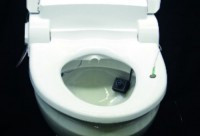 Fig. 1: The newly developed toilet recognizes the user and analyzes their stool and urineMuchhas been writtenaboutfacial recognition, but the inventors of a new health monitoring system hope to harness what could be described as technology at the other end of the scale. An intelligent toilet (Fig. 1) is the brainchild of scientists at Stanford University and is designed to act as a "benevolent Big Brother". It will analyze daily excretions and look for warning signs of disease, including certain types of cancer. To do this effectively, it needs to know which member of a household is responsible for each sample. This is achieved using a camera-based computer system that is able to distinguish one rear end from another. "It's about giving accurate, individualized health feedback, so we needed to make sure the toilet could distinguish between users," said Sanjiv Gambhir, professor and chairman of radiology at Stanford. His team initially made a flush lever that could read fingerprints. However, they found that this method was not entirely foolproof. What if one person used the toilet but another flushed?
Fig. 1: The newly developed toilet recognizes the user and analyzes their stool and urineMuchhas been writtenaboutfacial recognition, but the inventors of a new health monitoring system hope to harness what could be described as technology at the other end of the scale. An intelligent toilet (Fig. 1) is the brainchild of scientists at Stanford University and is designed to act as a "benevolent Big Brother". It will analyze daily excretions and look for warning signs of disease, including certain types of cancer. To do this effectively, it needs to know which member of a household is responsible for each sample. This is achieved using a camera-based computer system that is able to distinguish one rear end from another. "It's about giving accurate, individualized health feedback, so we needed to make sure the toilet could distinguish between users," said Sanjiv Gambhir, professor and chairman of radiology at Stanford. His team initially made a flush lever that could read fingerprints. However, they found that this method was not entirely foolproof. What if one person used the toilet but another flushed? Fig. 2: The death flight of Air France Flight 4590 at Charles de Gaulle Airport, Paris July 2000Europeled the world in civil supersonic flight half a century ago with the Anglo-French Concorde, but it was not a happy story. The planes themselves were not economical, they were incredibly noisy, and the US banned supersonic flight over its territory. The project came to a tragic end when an Air France Concorde, Flight 4590, carrying mainly German tourists, crashed in flames not far from Paris in July 2000. There were no survivors. Figure 2, as bad as it is, remains in our memories. Since then, there have been no serious attempts by European companies to revive civil supersonic flight. A largely parallel development was seen in the USSR, where 16 Tupolev Tu144 aircraft were produced. Two of them crashed, one of them dramatically at the Paris Air Show. The last flight took place in 1999. The Tu144 was strikingly similar to the Concorde, and there were many accusations of industrial espionage. In terms of military aircraft, the picture is very different, and many nations have supersonic jet fighters. As a result, there remains a wealth of expertise related to supersonic flight, including understanding the 'sonic boom' and how to reduce noise levels. While there seems to be little enthusiasm in Europe for a revival of supersonic flight, there has been much activity in America and it appears that we are on the cusp of a new era of supersonic passenger flight. The US government has now (slightly) relaxed the permissible noise levels, although supersonic flight over the US itself remains banned.
Fig. 2: The death flight of Air France Flight 4590 at Charles de Gaulle Airport, Paris July 2000Europeled the world in civil supersonic flight half a century ago with the Anglo-French Concorde, but it was not a happy story. The planes themselves were not economical, they were incredibly noisy, and the US banned supersonic flight over its territory. The project came to a tragic end when an Air France Concorde, Flight 4590, carrying mainly German tourists, crashed in flames not far from Paris in July 2000. There were no survivors. Figure 2, as bad as it is, remains in our memories. Since then, there have been no serious attempts by European companies to revive civil supersonic flight. A largely parallel development was seen in the USSR, where 16 Tupolev Tu144 aircraft were produced. Two of them crashed, one of them dramatically at the Paris Air Show. The last flight took place in 1999. The Tu144 was strikingly similar to the Concorde, and there were many accusations of industrial espionage. In terms of military aircraft, the picture is very different, and many nations have supersonic jet fighters. As a result, there remains a wealth of expertise related to supersonic flight, including understanding the 'sonic boom' and how to reduce noise levels. While there seems to be little enthusiasm in Europe for a revival of supersonic flight, there has been much activity in America and it appears that we are on the cusp of a new era of supersonic passenger flight. The US government has now (slightly) relaxed the permissible noise levels, although supersonic flight over the US itself remains banned. Fig. 3: The three-engine Overture, due to enter service in the mid-2020s, is being developed by Boom Supersonic.It goes without saying that the "green lobby" is deeply unhappy about these developments. All these new models will emit far moreCO2 per passenger-kilometer than the latest Airbus models. Some claim that their jet engines will run on biofuel - but at present it is far from clear whether a sufficient supply of biofuel for jet engines will be available (or how much it would cost). And Virgin, I note, has 30 aircraft on order with JAL. But the Australian airline Virgin Australia went bankrupt a few weeks ago, and Virgin Atlantic has said it will collapse unless it gets a €500 million loan from the UK government, which many believe it shouldn't as it is 49% owned by US-based Delta Airlines. These are not good times for airlines! Finally, there are those who believe that supersonic flight will in time be replaced by hypersonic rockets equipped with air-breathing engines and flying at altitudes close to the limit of the Earth's atmosphere.
Fig. 3: The three-engine Overture, due to enter service in the mid-2020s, is being developed by Boom Supersonic.It goes without saying that the "green lobby" is deeply unhappy about these developments. All these new models will emit far moreCO2 per passenger-kilometer than the latest Airbus models. Some claim that their jet engines will run on biofuel - but at present it is far from clear whether a sufficient supply of biofuel for jet engines will be available (or how much it would cost). And Virgin, I note, has 30 aircraft on order with JAL. But the Australian airline Virgin Australia went bankrupt a few weeks ago, and Virgin Atlantic has said it will collapse unless it gets a €500 million loan from the UK government, which many believe it shouldn't as it is 49% owned by US-based Delta Airlines. These are not good times for airlines! Finally, there are those who believe that supersonic flight will in time be replaced by hypersonic rockets equipped with air-breathing engines and flying at altitudes close to the limit of the Earth's atmosphere.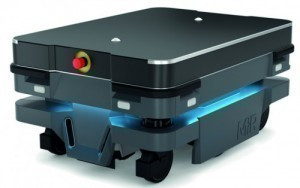 Fig. 4: The Mir 250 automated guided vehicleInternallogistics is a bottleneck for many companies due to the frequency and uniformity of tasks, combined with a shortage of skilled labor. Currently, there is a remarkable increase in demand for robots that can work in environments with a high number of obstacles, including humans.
Fig. 4: The Mir 250 automated guided vehicleInternallogistics is a bottleneck for many companies due to the frequency and uniformity of tasks, combined with a shortage of skilled labor. Currently, there is a remarkable increase in demand for robots that can work in environments with a high number of obstacles, including humans.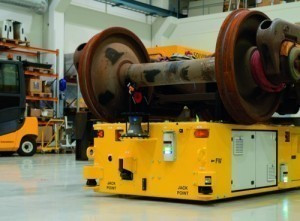 Fig. 5: AGV (Automatic Guided Vehicle) with 100 ton loadForthose who need a whole fleet of mobile robots to further optimize their workflows, additional robots can be added. In addition, the traffic flow between the robots is efficiently coordinated.
Fig. 5: AGV (Automatic Guided Vehicle) with 100 ton loadForthose who need a whole fleet of mobile robots to further optimize their workflows, additional robots can be added. In addition, the traffic flow between the robots is efficiently coordinated.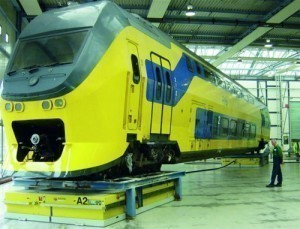 Fig. 6: Moving a railroad locomotiveUsinga combination of advanced battery technology, high capacity flat wheels and motors, loads of up to 100 tons can be programmed and guided safely and automatically through a complex series of movements to suit a variety of assembly processes.
Fig. 6: Moving a railroad locomotiveUsinga combination of advanced battery technology, high capacity flat wheels and motors, loads of up to 100 tons can be programmed and guided safely and automatically through a complex series of movements to suit a variety of assembly processes.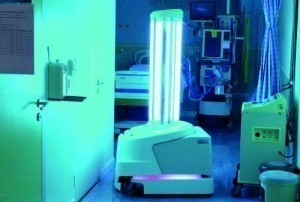 Fig. 7: UV disinfection robot from UVD Robotics in a hospitalThereis a cynical saying: "Never let a crisis go to waste", and there is no doubt that the current pandemic is good news for many robotics companies. Cleaning and disinfection tasks in particular lend themselves to robotics. Danish company UVD Robotics is one of the market leaders; Figure 7 shows their ultraviolet disinfection robot, which is now increasingly found in hospitals. It is claimed that these systems destroy 99.99% of pathogens.
Fig. 7: UV disinfection robot from UVD Robotics in a hospitalThereis a cynical saying: "Never let a crisis go to waste", and there is no doubt that the current pandemic is good news for many robotics companies. Cleaning and disinfection tasks in particular lend themselves to robotics. Danish company UVD Robotics is one of the market leaders; Figure 7 shows their ultraviolet disinfection robot, which is now increasingly found in hospitals. It is claimed that these systems destroy 99.99% of pathogens.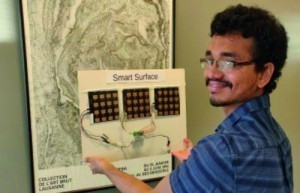 Fig. 8: A smart surface to boost Wi-Fi signal strengthThetechnology could benefit employees working remotely as well as students being taught remotely. It could also reduce interference from neighbors' Wi-Fi networks, making working or studying from home easier for everyone. In indoor tests, the smart surface extended the Wi-Fi range from 30 to 45 meters. It also doubled the data rate in areas already receiving a signal.
Fig. 8: A smart surface to boost Wi-Fi signal strengthThetechnology could benefit employees working remotely as well as students being taught remotely. It could also reduce interference from neighbors' Wi-Fi networks, making working or studying from home easier for everyone. In indoor tests, the smart surface extended the Wi-Fi range from 30 to 45 meters. It also doubled the data rate in areas already receiving a signal.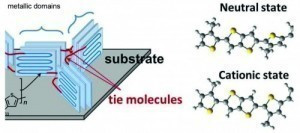 Fig. 9: Neutral and cationic state of a conductive polymerTwistingup atomic chains in a plastic polymer improves its ability to conduct electricity, according to a report by researchers led by applied physicist Hisaaki Tanaka of Nagoya University in the journal Science Advances. The findings could help accelerate the development of portable power sources for a wide range of Internet-of-Things devices.
Fig. 9: Neutral and cationic state of a conductive polymerTwistingup atomic chains in a plastic polymer improves its ability to conduct electricity, according to a report by researchers led by applied physicist Hisaaki Tanaka of Nagoya University in the journal Science Advances. The findings could help accelerate the development of portable power sources for a wide range of Internet-of-Things devices.

